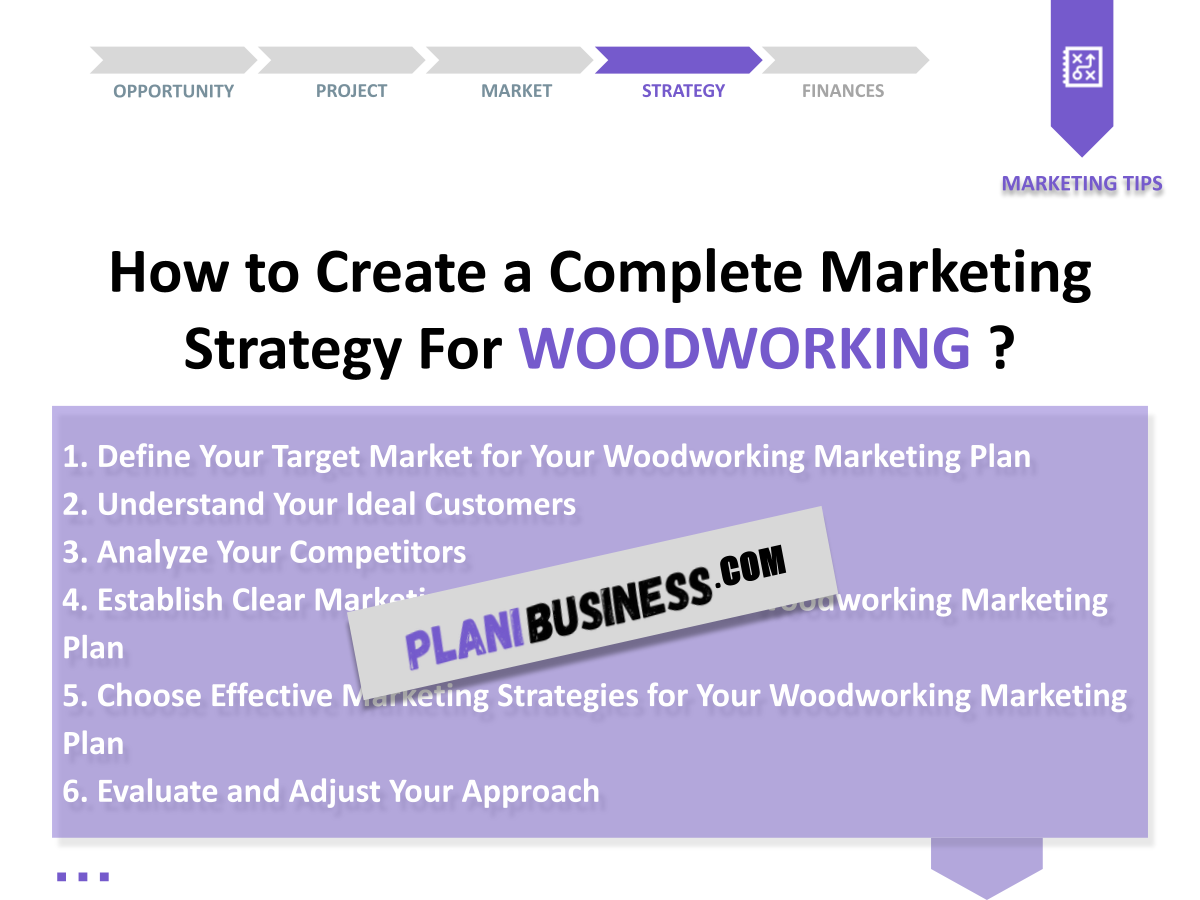Are you thinking about starting a woodworking marketing plan? You’re not alone! Many woodworkers struggle to find the best ways to showcase their craft and attract customers. In fact, about 70% of small businesses fail because they lack a solid marketing strategy. A woodworking marketing plan helps you define your audience, set clear goals, and choose effective marketing strategies to grow your business.
In this article, we will cover:
- Defining your target market
- Understanding your ideal customers
- Analyzing your competitors
- Establishing clear marketing objectives
- Choosing effective marketing strategies
- Evaluating and adjusting your approach
1. Define Your Target Market for Your Woodworking Marketing Plan
| Segment | Description | Importance |
|---|---|---|
| Demographics | Age, gender, income level | Identifies who to target |
| Geographics | Location-based preferences | Helps in local marketing |
Understanding your target market is crucial. It allows you to tailor your marketing messages effectively. You might find that your products appeal more to homeowners than to commercial clients.
To get started, consider creating a customer persona. This is a detailed profile of your ideal customer that includes demographics, interests, and buying behaviors. By knowing who your target market is, you can focus your marketing efforts on the right audience. For example, if your woodworking products are high-end furniture, your target market will likely be affluent homeowners looking for unique pieces.
2. Understand Your Ideal Customers
| Customer Profile | Interests | Buying Behaviors |
|---|---|---|
| DIY Enthusiasts | Home improvement projects | Purchase tools regularly |
| Interior Designers | Home aesthetics | Look for unique pieces |
Creating a detailed profile of your ideal customers helps you understand their needs and preferences. This way, you can create marketing content that resonates with them.
For instance, if you discover that your ideal customer is a DIY enthusiast, you might focus on creating engaging content that showcases how to use your products in home projects. On the other hand, if your customer is an interior designer, you should emphasize the quality and uniqueness of your pieces. Knowing your audience will not only help you market your products more effectively but will also enhance customer satisfaction and loyalty.
3. Analyze Your Competitors
| Competitor | Strengths | Weaknesses |
|---|---|---|
| Local Woodshop A | Strong community presence | Limited online reach |
| Online Store B | Wide product range | High shipping costs |
Competitor analysis is essential for a successful woodworking marketing plan. It helps you identify gaps in the market and areas where you can excel. By understanding what your competitors do well and where they fall short, you can position your business more effectively.
Start by identifying your main competitors. You can do this by searching online for woodworking businesses in your area or niche. Once you’ve identified them, create a list of their strengths and weaknesses. This can include aspects like product quality, pricing, customer service, and marketing strategies.
For example, if you find that a local competitor has a strong community presence but lacks an online store, you can leverage this by enhancing your online visibility. Consider offering free shipping or superior customer service to attract their customers. Remember, understanding your competition isn’t just about copying what they do; it’s about finding your unique selling proposition (USP) that sets you apart in the market.
4. Establish Clear Marketing Objectives for Your Woodworking Marketing Plan
| Objective | Measurement | Timeline |
|---|---|---|
| Increase website traffic | Monthly analytics review | 3 months |
| Boost social media followers | Follower count | 6 months |
Setting clear and measurable objectives gives you a roadmap for your marketing efforts. It allows you to track progress and adjust strategies as needed. Without specific objectives, it’s easy to lose focus and get sidetracked by less important tasks.
When establishing your marketing objectives, consider using the SMART criteria: Specific, Measurable, Achievable, Relevant, and Time-bound. For instance, instead of saying “I want to increase sales,” a SMART objective would be “I want to increase sales by 20% over the next six months.” This clarity helps you stay focused on what matters.
Additionally, regularly review your objectives. If you find that you’re not on track to meet them, analyze why and adjust your strategies accordingly. This might mean increasing your social media presence or investing in paid advertising to reach a broader audience. Remember, the ultimate goal of your woodworking marketing plan is to drive sales and grow your business.
5. Choose Effective Marketing Strategies for Your Woodworking Marketing Plan
| Strategy | Description | Expected Outcome |
|---|---|---|
| Social Media Advertising | Targeted ads on platforms like Instagram | Increased visibility and engagement |
| Email Marketing | Regular newsletters to subscribers | Higher engagement and customer retention |
Choosing the right strategies is vital for your woodworking marketing plan. Each strategy should align with your objectives and resonate with your target audience. For example, if your ideal customers are active on social media, investing in social media advertising can significantly boost your visibility.
Here are a few effective marketing strategies you might consider:
- Content Marketing: Create valuable content such as blog posts, videos, or how-to guides that showcase your woodworking skills and products.
- Search Engine Optimization (SEO): Optimize your website with relevant keywords to improve your visibility on search engines.
- Networking: Attend local craft fairs, trade shows, or community events to connect with potential customers and other woodworkers.
- Referral Programs: Encourage satisfied customers to refer friends by offering discounts or rewards.
Remember, it’s not just about choosing any strategy; it’s about selecting the ones that fit your brand and will yield the best results. Monitor the effectiveness of each strategy and be willing to pivot if something isn’t working as expected.
6. Evaluate and Adjust Your Approach
| Metric | Target | Action |
|---|---|---|
| Website Traffic | Increase by 20% | Revise SEO strategy if not met |
| Sales Conversion Rate | Improve by 15% | Refine sales funnel and customer experience |
Regular evaluation of your marketing efforts ensures you stay on track. If something isn’t working, don’t hesitate to make changes. Use analytics tools to track your progress and identify areas for improvement.
For instance, if your website traffic isn’t increasing as expected, delve into your SEO strategy. Are you using the right keywords? Is your content engaging? Adjusting your approach based on data can lead to significant improvements.
Moreover, consider gathering feedback from your customers. This could be through surveys or direct conversations. Understanding their experience can provide insights into what’s working and what needs to change. The key to a successful woodworking marketing plan is adaptability. Stay flexible and be willing to pivot your strategies as necessary to achieve your goals.
7. Example N°1 of Marketing Plan for a Custom Furniture Maker
| Steps | Actions | Details |
|---|---|---|
| Target Market | Identify high-income households | Focus on quality and craftsmanship |
| Ideal Customers | Target luxury homeowners | Market exclusivity |
| Competitors | Research local high-end furniture stores | Analyze pricing strategies |
| Marketing Objectives | Increase local market share | Set a goal of 25% growth |
| Marketing Strategies | Attend local trade shows | Network and showcase products |
| Evaluation | Quarterly sales reviews | Adjust marketing tactics as needed |
This marketing plan for a custom furniture maker outlines how to effectively target and grow within a niche market. By identifying high-income households as the target market, the business can focus on crafting premium products that resonate with this audience.
Attending local trade shows is a great way to connect with potential customers and showcase the quality of your work. This face-to-face interaction can help build trust and increase brand loyalty. Additionally, setting clear marketing objectives, such as a 25% increase in local market share, provides a measurable goal to strive for.
Regular evaluations through quarterly sales reviews ensure that the business stays on track and can adjust its strategies to meet evolving market demands. This example illustrates the importance of a focused approach in a woodworking marketing plan.
8. Example N°2 of Marketing Plan for a Woodworking Hobbyist Turning Professional
| Steps | Actions | Details |
|---|---|---|
| Target Market | Identify local DIY enthusiasts | Focus on affordable, practical products |
| Ideal Customers | Target hobbyists and beginner woodworkers | Emphasize ease of use |
| Competitors | Research local workshops and online platforms | Identify unique selling points |
| Marketing Objectives | Build a loyal customer base | Achieve a 30% return customer rate |
| Marketing Strategies | Host workshops and classes | Engage with the community |
| Evaluation | Monitor customer feedback and sales | Adjust product offerings accordingly |
This marketing plan for a woodworking hobbyist transitioning into a professional highlights the importance of community engagement. By targeting local DIY enthusiasts, the business can focus on providing affordable and practical products that meet their needs.
Hosting workshops and classes not only showcases the products but also builds a community around the brand. This hands-on approach allows potential customers to experience the quality of the products firsthand, increasing the likelihood of conversion.
Setting a marketing objective of achieving a 30% return customer rate ensures that the business focuses on building long-term relationships rather than just one-time sales. Regularly monitoring customer feedback will help refine product offerings and enhance customer satisfaction, making this example a solid reference for a successful woodworking marketing plan.
9. Example N°3 of Marketing Plan for a Specialty Woodworker
| Steps | Actions | Details |
|---|---|---|
| Target Market | Identify eco-conscious consumers | Focus on sustainable wood products |
| Ideal Customers | Target environmentally aware homeowners | Highlight the benefits of sustainability |
| Competitors | Research other sustainable woodworkers | Analyze their marketing strategies |
| Marketing Objectives | Increase brand awareness by 40% | Utilize social media and partnerships |
| Marketing Strategies | Collaborate with eco-friendly brands | Cross-promote products and services |
| Evaluation | Assess engagement metrics and sales | Refine strategies based on data |
This marketing plan for a specialty woodworker emphasizes the growing demand for sustainable products. By identifying eco-conscious consumers as the target market, the business can cater to a niche that values sustainability and quality.
Collaborating with other eco-friendly brands can expand your reach and enhance your credibility in the market. For example, co-hosting events or creating bundled offers with sustainable home goods can attract like-minded customers.
Setting a marketing objective to increase brand awareness by 40% through social media engagement and partnerships will ensure that the business effectively communicates its values. Regularly assessing engagement metrics will help in adjusting the marketing approach, making this example a valuable reference for a focused woodworking marketing plan.
10. Example N°4 of Marketing Plan for a Furniture Restoration Business
| Steps | Actions | Details |
|---|---|---|
| Target Market | Identify vintage furniture enthusiasts | Focus on restoration and customization |
| Ideal Customers | Target homeowners and collectors | Highlight unique restoration stories |
| Competitors | Research local restoration services | Identify gaps in service offerings |
| Marketing Objectives | Achieve a 25% increase in inquiries | Utilize targeted online advertising |
| Marketing Strategies | Showcase before-and-after photos | Engage customers on social media |
| Evaluation | Track inquiries and conversion rates | Adjust marketing tactics based on results |
This marketing plan for a furniture restoration business focuses on connecting with vintage furniture enthusiasts who appreciate craftsmanship and history. By targeting this niche market, the business can highlight the unique stories behind each piece it restores.
Utilizing before-and-after photos on social media is an effective way to showcase the skills and transformations that your business can achieve. This not only attracts potential customers but also builds credibility and trust in your expertise.
Setting a marketing objective to achieve a 25% increase in inquiries through targeted online advertising will help measure success. Tracking inquiries and conversion rates allows for continuous improvement, making this example a practical guide for an effective woodworking marketing plan.
11. Example N°5 of Marketing Plan for a Woodworking Supply Store
| Steps | Actions | Details |
|---|---|---|
| Target Market | Identify local woodworkers and DIYers | Focus on providing quality tools and materials |
| Ideal Customers | Target hobbyists and professionals | Emphasize product variety and availability |
| Competitors | Analyze local and online competitors | Identify unique selling propositions |
| Marketing Objectives | Increase foot traffic by 30% | Utilize local advertising and promotions |
| Marketing Strategies | Run in-store workshops and demos | Engage customers and build community |
| Evaluation | Monitor sales and customer feedback | Adjust inventory and marketing tactics |
This marketing plan for a woodworking supply store focuses on attracting local woodworkers and DIY enthusiasts by providing a diverse range of tools and materials. By identifying this target market, the store can tailor its offerings to meet the specific needs of both hobbyists and professionals.
Running in-store workshops and demonstrations is an excellent strategy to engage customers and create a community around the store. These events not only showcase products but also foster relationships with customers, encouraging repeat visits.
Setting a marketing objective to increase foot traffic by 30% through local advertising and promotions helps to measure success. Monitoring sales and customer feedback will allow the store to adjust inventory and marketing tactics, ensuring it remains competitive in the market.
12. Example N°6 of Marketing Plan for a Woodworking Online Course
| Steps | Actions | Details |
|---|---|---|
| Target Market | Identify aspiring woodworkers | Focus on beginners and intermediate levels |
| Ideal Customers | Target individuals looking to learn woodworking | Highlight flexibility and accessibility |
| Competitors | Research existing online woodworking courses | Identify gaps and unique features |
| Marketing Objectives | Enroll 200 students in the first quarter | Utilize online advertising and SEO |
| Marketing Strategies | Offer free introductory classes | Attract potential students |
| Evaluation | Track enrollment numbers and feedback | Refine course content and marketing strategies |
This marketing plan for an online woodworking course targets aspiring woodworkers who are eager to learn. By focusing on beginners and intermediate levels, the course can cater to a wide audience looking for accessible and flexible learning options.
Offering free introductory classes is a great strategy to attract potential students and showcase the quality of the content. This not only builds trust but also encourages sign-ups for the full course.
Setting a marketing objective to enroll 200 students in the first quarter through online advertising and SEO ensures that the course reaches its target audience effectively. Tracking enrollment numbers and feedback will allow for continuous improvement, making this example a practical guide for a successful woodworking marketing plan.
13. Example N°7 of Marketing Plan for a Custom Cabinet Maker
| Steps | Actions | Details |
|---|---|---|
| Target Market | Identify homeowners renovating kitchens | Focus on high-quality custom solutions |
| Ideal Customers | Target families and couples | Emphasize functionality and aesthetics |
| Competitors | Research local cabinet makers | Analyze their pricing and offerings |
| Marketing Objectives | Increase leads by 50% in 6 months | Utilize targeted online ads and referrals |
| Marketing Strategies | Create a portfolio of past projects | Showcase craftsmanship and variety |
| Evaluation | Review lead generation sources | Adjust marketing strategies based on performance |
This marketing plan for a custom cabinet maker focuses on attracting homeowners who are renovating their kitchens. By identifying this target market, the business can offer tailored solutions that meet the specific needs of families and couples looking for high-quality custom cabinetry.
Creating a portfolio of past projects is an effective strategy to showcase craftsmanship and the variety of options available. This visual representation can help potential customers envision the possibilities for their own spaces.
Setting a marketing objective to increase leads by 50% in 6 months through targeted online ads and referrals ensures the business can measure its success effectively. Regularly reviewing lead generation sources will allow for adjustments in marketing strategies, making this example a comprehensive reference for a successful woodworking marketing plan.
Conclusion
In conclusion, crafting a successful woodworking marketing plan is essential for any woodworking business looking to thrive in a competitive market. By defining your target market, understanding your ideal customers, analyzing competitors, and setting clear marketing objectives, you can create a robust strategy that drives growth and engagement.
Don’t forget to continually evaluate and adjust your approach based on performance metrics and customer feedback. If you’re looking for a comprehensive guide to starting your woodworking business, check out this woodworking business plan template to help you get started on the right foot.
Additionally, for further insights, you can explore our articles on How to Begin a Woodworking Business? and learn how to create a SWOT analysis for woodworking. These resources will provide you with valuable information to enhance your woodworking journey!
FAQ
- What is a woodworking marketing plan?
A woodworking marketing plan is a strategic outline that helps woodworking businesses define their target audience, set marketing objectives, and choose effective strategies to promote their products. - How do I identify my target market in woodworking?
To identify your target market, analyze demographics, interests, and purchasing behaviors of potential customers who are likely to buy your woodworking products. - What marketing strategies work best for woodworking businesses?
Effective marketing strategies for woodworking businesses include social media advertising, content marketing, workshops, and email marketing. - How can I evaluate the effectiveness of my woodworking marketing plan?
You can evaluate the effectiveness of your marketing plan by tracking metrics such as website traffic, conversion rates, and customer feedback. - What are common pain points for customers in woodworking?
Common pain points include finding quality materials, understanding woodworking techniques, and managing project costs. - How can I differentiate my woodworking business from competitors?
You can differentiate your business by offering unique products, exceptional customer service, and showcasing your craftsmanship through quality content. - What role does social media play in woodworking marketing?
Social media is crucial for building brand awareness, engaging with customers, and showcasing your products through visual content. - How can I increase customer loyalty in my woodworking business?
Increase customer loyalty by providing excellent service, engaging with your audience, and offering loyalty programs or referral incentives. - Is SEO important for woodworking businesses?
Yes, SEO is vital as it helps improve your website’s visibility on search engines, making it easier for potential customers to find your woodworking products. - What are some examples of successful woodworking marketing campaigns?
Successful campaigns often include community engagement through workshops, collaborations with local businesses, and targeted online advertising.







